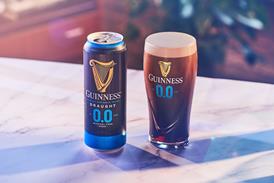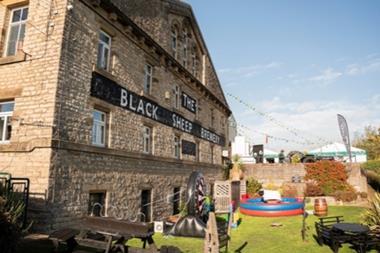FMCG land is harsh, and it doesn't welcome newcomers. Only one in 10 new products is still on shelves a year later and most need massive marketing muscle behind them to have any hope of long-term survival. Brand owners are rarely benevolent parents and culls of poor performers are becoming more common.
At the same time, consumers continue to demand more; more taste, more variety, more convenience, and introducing products which meet these requirements to market is expensive and risky.
Finding a partner is a way to reduce the risks. Companies have long flirted with cross-promotions and licensing agreements, but now the number of more intimate couplings is increasing.
Recent engagements include Britvic and Cadbury pairing up to launch a limited edition Tango Crunchie in October 2000; Müller and Kellogg's coming together to produce Müller Corners with Kellogg's Cereals in January this year: and Walkers and Heinz choosing to walk up the savoury snacks aisle with Heinz Tomato Ketchup Flavoured Walkers Crisps in June.
According to Professor Peter Doyle of Warwick University Business School, these links are to be expected. "If there's one major trend across the business world these days, it's towards strategic alliances and networking, so it's no wonder the number of dual branding projects is increasing," he says.
While not quite marriages made in heaven, these liaisons offer several advantages, says Doyle. "They offer access to new markets both distribution and consumers considerably more cheaply than going solo. They bring in new customers who are perhaps already primed for the product and they add value."
Sheila Tully, director at brand consultancy Appetite, agrees: "For consumers, brands are a shorthand. They are easier to buy into, and easier to sell into the trade. And there is more widespread recognition of their value. Using consumers' relationships with brands to maximise take up of a product makes sense. By combining brands, companies increase the appeal and potential likelihood to buy. "
And, in spite of the resulting cumbersome product names, these combinations can be a recipe for quick success.
Cadbury says its Tango Crunchie sold 40% better than previous limited editions, and although it's early days for Walkers' partnership with Heinz, it says the product is achieving ambitious targets. Müller's md, Ken Wood, describes the venture with Kellogg's as "a resounding success and very much incremental business".
Synergy between the brands involved is one of the key factors behind successful fusions. Tango and Crunchie have similar core target audiences and routes to market and impulse outlets are important for both, while Heinz Tomato Ketchup's consumer target young people gelled with Walkers.
"It's a good fit for both," says Steve Turner, Heinz UK general manager for ketchup, condiments and sauces. "These are very big brands and they're not competitors; there's no conflict of interest and there's a reasonable quid pro quo. Our branding on millions of bags of crisps and extra TV coverages reinforce the message that Heinz is the ketchup."
For Müller and Kellogg the yogurt/cereal venture took both into new territory. Müller moved further into breakfast while Kellogg got a firmer foothold in snacking as its traditional market, the sit down breakfast, continues to decline.
Says Appetite's Tully: "Both have ambitions in the casual eating market. Cereals are not normally found in the chiller cabinet as they're not generally considered as convenience food. And a yogurt with cornflakes does not sound as appealing as Müller with Kellogg's Cornflakes. Ultimately it works for both by creating a new eating experience and in leveraging each other's brands."
Alcohol brands also have a history of success in dual branding. Guinness UDV's Gordon's and Schweppes brands have been entwined since the launch of their joint product in 1996, while the company has also worked with Häagen-Dazs to create ice creams flavoured with Baileys and Malibu. The Baileys version is one of Häagen-Dazs's bestsellers.
Soft drink specialist AG Barr, undaunted by the failure of an earlier collaboration with Bell's whisky, teamed up instead with Halewood to produce Vodka Red Square Irn-Bru. Beverage Brands features Jim Beam Brands' Vladivar in three of its Woody's Cocktail range of premium packaged spirits.
Beverage Brands marketing manager Karen Salters says: "The target markets of the two brands are the same so it makes sense to collaborate and give the consumer a richer offer. It helps to elevate the brand, gives a quality reassurance and reinforces the premium pricing."
These successful drink partnerships, like the food pairings, have combined in one of two ways. They either create a new product in the same market or one brand operates as a host for the other's flavour. Walkers and Cadbury each provided the host product and proposed the arrangement and each half brought different marketing dowries with them. "It was an even partnership in that we both agreed the objectives but Cadbury funded the above-the-line activity of press and radio ads, while trade activity was funded jointly," says Cathryn Sleight, Britvic's director of marketing.
Walker's has thrown £3.5m behind its new crisps with a Sir Steve Redgrave/Gary Lineker ad campaign, while Heinz Tomato Ketchup currently sports labels prompting its fans to go exploring the snacks fixture too. Kellogg promoted its debut in the chiller cabinet on its cereal boxes.
Different marketing strategies and inappropriate pairings can cause problems, however. One such collaboration produced a very short-lived McEwan's Export Arran Mustard. Brian Sharp, marketing director for McEwan's brand owner Scottish Courage, says: "Dual branding is a logical thing to do for big brands if it is going to be beneficial to both, but here we could not quite find that logic."
Mismatches in target markets may alienate both groups, while teaming a mass market brand with a luxury one is unlikely to work. The combined weight of two big brands would make any fall much heavier.
One liaison which avoided all the major pitfalls and yet still didn't have a happy ending was between breaded poultry specialist Sun Valley and ethnic sauce player Sharwood's.
They came together to launch a range of stir fries in April 1998 raw chicken, with a sauce marinade and vegetables for stir frying. Hopes were high, with Sharwood's predicting sales of £6m - £9m in the first year.
The project's pedigree was strong. Both brands inspired consumer trust and carried the assurance of authenticity and quality in their respective fields. The product tested well and was listed across the trade. Sun Valley looked set to gain a presence in ethnic foods and Sharwood's in meals.
But it didn't work. Sales were so disappointing the range was pulled within a year.
A Sun Valley spokeswoman insists that the product was ahead of its time. "Consumers were confused by it and retailers didn't know where to site it," she says. "It contained raw meat so it couldn't sit on the ready meals fixture, but it couldn't stay with raw meat because of the sauce content."
And this may be another lesson. A product that has to be sited away from both parent brands may not attract their fans and may end up with no real home.
For those partners whose new baby could remain close to at least one parent, dual branding has generally proved so encouraging that further family expansion could be on the cards. The marketing teams involved speak highly of the level of satisfaction involved and the usefulness in pooling ideas.
Heinz's Turner says that the company "wouldn't rule out" further expeditions outside the bottle for its tomato ketchup, while Britvic says it is discussing future deals with Cadbury and others. Wood says Müller is looking to "broaden its relationship" with Kellogg, and may look to its current distribution deal with Tropicana for new dual branding possibilities.
Wood also points out that the speed and smoothness of a deal coming together are good indicators of its probable success. "If an idea that involves another brand takes a year or two to get off the ground, then it probably wasn't meant to be," he says.
The phenomenon is unlikely to become too widespread. There are few perfect prospective pairings in grocery's lonely hearts columns and even some for whom a link up has been successful, hint at a "love 'em and leave 'em" attitude. For example, Chris Morgan, Cadbury's customer relations director, says the Tango Crunchie link up was always going to be shortlived. "These things have a very limited life," he adds. " The novelty wears off."
And alas, some brand romances will always be star-crossed, in spite of the probable impact of their offspring. A Mars Bar Baxters' soup, Marmite Tetley tea bags or Tia Maria Fairy Liquid would certainly make life interesting. However, other fusions would stand a fighting chance. What odds on Jaffa Cakes Carte D'Or ice cream, Chanel Andrex, or Coca-Cola Mr Kipling cakes?
{{FEATURES }}
Close menu
- Home
- Retail & Wholesale
-
Products & Suppliers
- Back to parent navigation item
- Products & Suppliers
-
Product Categories:
- Back to parent navigation item
- Product Categories:
- Alcoholic drinks
- Bakery
- Cereals & breakfast
- Cheese
- Chicken & poultry
- Chocolate
- Confectionery
- Crisps, nuts & snacks
- Dairy
- Fish
- Fresh produce
- Frozen
- Household
- Meat
- Own Label
- Sauces & condiments
- Seasonal
- Soft drinks
- Vaping
- Vegan & plant-based
- World foods
- Suppliers
- People
- Reports & Data
-
Topics A-Z
- Back to parent navigation item
- Topics A-Z
-
Popular topics:
- Back to parent navigation item
- Popular topics:
- Cost of living crisis
- Crime
- Deposit Return Schemes
- Finance
- Government & Regulation
- Health
- Inflation
- Loyalty
- Marketing
- Mergers & Acquisitions
- New Product Development
- Sourcing
- Supply chain
- Sustainability & environment
- Technology
- Ultra Processed Foods
- Vaping
- A-Z all topics
- Content by type:
- Events
- Ask iA (beta)
- Subscribe now
Sign in to comment on this article
Not logged in before? Register for FREE guest access today.
You will be able to:
- Read more stories
- Receive daily newsletters
- Comment on stories
Advert














No comments yet